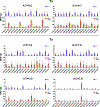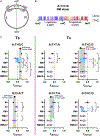Effect of mismatch repair on the mutational footprint of the bacterial SOS mutator activity
- PMID: 33991871
- PMCID: PMC8206030
- DOI: 10.1016/j.dnarep.2021.103130
Effect of mismatch repair on the mutational footprint of the bacterial SOS mutator activity
Abstract
The bacterial SOS response to DNA damage induces an error-prone repair program that is mutagenic. In Escherichia coli, SOS-induced mutations are caused by the translesion synthesis (TLS) activity of two error-prone polymerases (EPPs), Pol IV and Pol V. The mutational footprint of the EPPs is confounded by both DNA damage and repair, as mutations are targeted to DNA lesions via TLS and corrected by the mismatch repair (MMR) system. To remove these factors and assess untargeted EPP mutations genome-wide, we constructed spontaneous SOS mutator strains deficient in MMR, then analyzed their mutational footprints by mutation accumulation and whole genome sequencing. Our analysis reveals new features of untargeted SOS-mutagenesis, showing how MMR alters its spectrum, sequence specificity, and strand-bias. Our data support a model where the EPPs prefer to act on the lagging strand of the replication fork, producing base pair mismatches that are differentially repaired by MMR depending on the type of mismatch.
Keywords: DNA polymerase IV; DNA polymerase V; Error-prone polymerases; Mismatch repair; Mutation accumulation whole genome sequencing; SOS response.
Copyright © 2021 Elsevier B.V. All rights reserved.
Figures





Similar articles
-
New complexities of SOS-induced "untargeted" mutagenesis in Escherichia coli as revealed by mutation accumulation and whole-genome sequencing.DNA Repair (Amst). 2020 Jun;90:102852. doi: 10.1016/j.dnarep.2020.102852. Epub 2020 Apr 18. DNA Repair (Amst). 2020. PMID: 32388005 Free PMC article.
-
Genetic requirements and mutational specificity of the Escherichia coli SOS mutator activity.J Bacteriol. 1997 Dec;179(23):7435-45. doi: 10.1128/jb.179.23.7435-7445.1997. J Bacteriol. 1997. PMID: 9393709 Free PMC article.
-
SOS mutator activity: unequal mutagenesis on leading and lagging strands.Proc Natl Acad Sci U S A. 2000 Nov 7;97(23):12678-83. doi: 10.1073/pnas.220424697. Proc Natl Acad Sci U S A. 2000. PMID: 11050167 Free PMC article.
-
A Comprehensive View of Translesion Synthesis in Escherichia coli.Microbiol Mol Biol Rev. 2020 Jun 17;84(3):e00002-20. doi: 10.1128/MMBR.00002-20. Print 2020 Aug 19. Microbiol Mol Biol Rev. 2020. PMID: 32554755 Free PMC article. Review.
-
Eukaryotic Mismatch Repair in Relation to DNA Replication.Annu Rev Genet. 2015;49:291-313. doi: 10.1146/annurev-genet-112414-054722. Annu Rev Genet. 2015. PMID: 26436461 Free PMC article. Review.
Cited by
-
The low-fidelity DNA Pol IV accelerates evolution of pathogenicity genes in Pseudomonas aeruginosa.Commun Biol. 2025 Aug 2;8(1):1148. doi: 10.1038/s42003-025-08589-5. Commun Biol. 2025. PMID: 40753298 Free PMC article.
-
RNA polymerase stalling-derived genome instability underlies ribosomal antibiotic efficacy and resistance evolution.Nat Commun. 2024 Aug 3;15(1):6579. doi: 10.1038/s41467-024-50917-6. Nat Commun. 2024. PMID: 39097616 Free PMC article.
-
Sending out an SOS - the bacterial DNA damage response.Genet Mol Biol. 2022 Oct 10;45(3 Suppl 1):e20220107. doi: 10.1590/1678-4685-GMB-2022-0107. eCollection 2022. Genet Mol Biol. 2022. PMID: 36288458 Free PMC article.
-
Contribution of the SOS response and the DNA repair systems to norfloxacin induced mutations in E. coli.Mar Life Sci Technol. 2023 Sep 21;5(4):538-550. doi: 10.1007/s42995-023-00185-y. eCollection 2023 Nov. Mar Life Sci Technol. 2023. PMID: 38045542 Free PMC article.
References
-
- Friedberg EC, Walker GC, Siede W, DNA repair and mutagenesis, ASM Press, Washington, D.C., 1995.
-
- Tang M, Pham P, Shen X, Taylor JS, O’Donnell M, Woodgate R, Goodman MF, Roles of E. coli DNA polymerases IV and V in lesion-targeted and untargeted SOS mutagenesis, Nature, 404 (2000) 1014–1018. - PubMed
-
- Kobayashi S, Valentine MR, Pham P, O’Donnell M, Goodman MF, Fidelity of Escherichia coli DNA polymerase IV. Preferential generation of small deletion mutations by dNTP-stabilized misalignment, J Biol Chem, 277 (2002) 34198–34207. - PubMed
-
- Jarosz DF, Beuning PJ, Cohen SE, Walker GC, Y-family DNA polymerases in Escherichia coli, Trends in microbiology, 15 (2007) 70–77. - PubMed
Publication types
MeSH terms
Grants and funding
LinkOut - more resources
Full Text Sources
Other Literature Sources
Molecular Biology Databases

